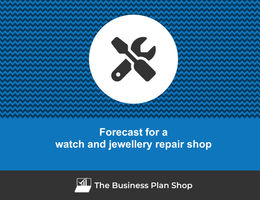How to open a watch and jewellery repair shop?
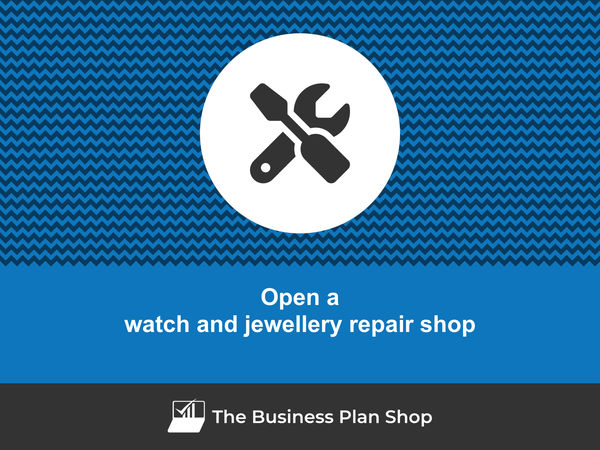
Are you keen to open a watch and jewellery repair shop but don't know where to begin? Then you're in luck because this guide will lead you through all the steps required to check if your business idea can be profitable and, if so, turn it into a reality.
Our guide is for prospective entrepreneurs who are thinking about starting a watch and jewellery repair shop no matter how far they are in their journey - whether you’re just thinking about it or in the middle of market research this guide will be useful to you.
Think of this as your blueprint: we cover everything you need to know about opening a watch and jewellery repair shop and what key decisions you’ll need to make along the way.
Ready? Let’s get started!
Understanding how a watch and jewellery repair shop works
The very first step when exploring a business idea such as starting a watch and jewellery repair shop is to make sure you understand how the business operates and makes money (which is what we call the business model).
This will not only give you an initial idea of how profitable the business can be, but it will also enable you to make sure that this is the right business idea for you, given your skills, start-up capital and family or personal lifestyle, in particular.
The best ways to get to grips with the watch and jewellery repair shop's business model are to:
- Talk to watch and jewellery repair shop owners with experience
- Work a few months in a watch and jewellery repair shop already in operation
- Take a training course
Talk to watch and jewellery repair shop owners with experience
Experienced watch and jewellery repair shop owners have valuable insights and can provide practical advice based on their firsthand experiences.
They've likely encountered and overcome challenges that a newcomer might not anticipate. Learning from other’s mistakes can save you both time and money and potentially increase your venture’s chances of succeeding.
Work a few months in a watch and jewellery repair shop already in operation
Obtaining work experience in the industry can be a crucial factor in confirming whether you truly want to start a watch and jewellery repair shop, as it provides insight into the day-to-day activities.
For instance, if the working hours are longer than expected or if other business requirements don't align with your personal lifestyle or preferences, you might reconsider your entrepreneurial goals.
Even if you've decided that this business idea is a good fit for you, gaining work experience will still be valuable. It helps you better understand your target market and customer needs, which is likely to be beneficial when launching your own watch and jewellery repair shop.
Take a training course
Obtaining training within your chosen industry is another way to get a feel for how a watch and jewellery repair shop works before deciding to pursue a new venture.
Whatever approach you choose to familiarise yourself with the business, before going any further with your plans to open a watch and jewellery repair shop, make sure you understand:
- What skills are required to run the business (compare this with your own skills)
- What a typical week in the business is like (compare this with your personal or family life)
- What is the potential turnover of a watch and jewellery repair shop and the long-term growth prospects (compare this with your level of ambition)
- Your options once you decide to sell the business or retire (it's never too early to consider your exit)
Can your business idea be profitable?
Just enter your data and let The Business Plan Shop crunch the numbers. We will tell if your business idea can generate profits and cash flows, and how much you need to get started.
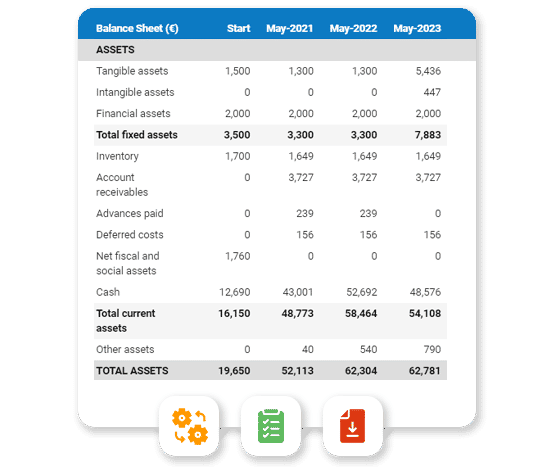
Assembling your watch and jewellery repair shop's founding team
The next step to opening your watch and jewellery repair shop is to think about the ideal founding team, or to decide to go in alone.
Starting and growing a successful business doesn't have to be a solo journey and setting up a watch and jewellery repair shop with several co-founders is generally easier. The business benefits from a management team with a wider skillset, decisions are made together, and the financial risk is shared among the partners, making the journey more collaborative and less daunting.
But, running a business with several partners brings its own challenges. Disagreements between co-founders are quite common, and these can pose risks to the business. That's why it's crucial to consider all aspects before starting your own business.
We won't go into too much detail here, as this is a complex topic that deserves its own guide, but we do recommend that you ask yourself the following questions:
- What is the ideal number of co-founders for this venture?
- Are you on the same wavelength as your potential partners in terms of vision and ambition?
- How will you deal with potential failure?
Let's look at each of these questions in more detail.
What is the ideal number of co-founders for this venture?
To answer this question you will need to consider the following:
- What skills do you need to run the business? Are you lacking any?
- How much startup capital do you need? How much do you have?
- How are key decisions going to be made? - It is usually advisable to have an odd number of partners (or a majority shareholder) to help break the tie.
Put simply, your co-founders contribute skills, capital, or both. Increasing the number of partners becomes advantageous when there is a deficiency in either of these resources.
Are you on the same wavelength as your potential partners in terms of vision and ambition?
Your business partners should share the same short and long-term vision, be it business expansion or social responsibility, to avoid future frustrations and simplify decision-making. Different views are natural, but alignment is ideal.
In any case, you should think of having an exit mechanism in place in case one of the partners wants to move on.
How will you deal with potential failure?
We wish you nothing but success when starting up and growing your watch and jewellery repair shop, but it's always wise to have a backup in case things don't go as planned.
How you deal with a potential failure can vary significantly based on the relationship you have with your business partner (close friend, spouse, ex-colleague, etc.) and the personal circumstances of each of you.
For instance, starting a business with your spouse might seem appealing, but if it doesn't succeed, you risk losing 100% of the household income at once, which could be stressful.
Similarly, going into a partnership with a friend can put pressure on the friendship in the event of failure or when you need to make difficult decisions.
There is no wrong answer, but it is essential to carefully evaluate your options before starting up to ensure you're well-prepared for any potential outcomes.
Undertake market research for a watch and jewellery repair shop
The next step to start your watch and jewellery repair shop is to use market research to check that there is indeed an opportunity to be seized. Let's take a look at what this involves.
The objectives of market research
In a nutshell, doing market research enables you to verify that there is a business opportunity for your company to seize, and to size the opportunity precisely.
First of all, market research enables you to assess whether the market you're targeting is large enough to withstand the arrival of a new competitor: your watch and jewellery repair shop.
The market analysis will also help you define the product and service offering of your watch and jewellery repair shop, and transcribe it into a market positioning and concept that will strike a chord with your target customers.
Finally, your market research will provide you with the data you need to draw up your sales and marketing plan and estimate the revenue potential of your watch and jewellery repair shop.
Analyse key trends in the industry
Market research for a watch and jewellery repair shop must always begin with a thorough investigation of consumer habits and current industry trends.
Normally, watch and jewellery repair shop market research begins with a sectorial analysis which will provide you with a better understanding of how the industry is organized, who the major players are, and what are the current market trends.
Assess the demand
A demand analysis enables you to accurately assess the expectations of your watch and jewellery repair shop's future customers.
Your analysis will focus on the following questions:
- How many potential customers are present in the geographical areas served by your company?
- What are their expectations and purchasing behaviors?
- How much are they willing to spend?
- Are there different customer segments with distinct characteristics?
- How to communicate and where to promote your business to reach your target market?
The main goal of your demand analysis is to identify potential customer segments that your watch and jewellery repair shop could target and what products or services would meet these customers' expectations.
Supply side
Supply-side analysis looks at the products and services offered by your competitors on the market.
You should focus here on the following questions:
- Who will your competitors be?
- Are they any good?
- Where are they located?
- Who do they target?
- What range of products and services do they offer?
- Are they small independent players?
- What prices do they charge?
- How do they sell their products and services?
- Do their concepts appeal to customers?
One of the aims of your supply-side analysis will be to gather the elements that will enable you to define a market positioning that will set you apart from what is already being done on the market, so as to avoid direct confrontation with competitors already established (more on that below).
Regulations
Market research is also an opportunity to look at the regulations and conditions required to do business.
You should ask yourself the following questions:
- Does it take a specific degree to open a watch and jewellery repair shop?
- Do you need specific licences or business permits?
- What are the main regulations applicable to your future business?
Given that your project is still in its early stages, your analysis of the regulation can be carried out at a high level for the time being. You just want to identify the main laws applicable and check that you meet the conditions for running this type of business before going any further.
Once your project is more advanced, you can come back to the regulation in greater detail with your lawyer.
Concluding your market research
Your market research should lead you to draw a clear conclusion about your chances of commercial success of your business idea:
- Either the market is saturated, and you'd better look into another business idea.
- Or there's an opportunity to be seized in the geographical area you're considering, and you can go ahead with your project to open a watch and jewellery repair shop.
Need a convincing business plan?
The Business Plan Shop makes it easy to create a financial forecast and write a business plan to help convince investors that your business idea can be profitable.

Choosing the right concept and positioning for your watch and jewellery repair shop
Once your market research is completed, it's time to consider the type of watch and jewellery repair shop you want to open and define precisely your company's market positioning in order to capitalise on the opportunity you identified during your market research.
Market positioning refers to the place your product and service offering occupies in customers' minds and how they differ from competing products and services. Being perceived as the premium solution, for example.
There are four questions you need to consider:
- How will you compete with and differentiate yourself from competitors already on the market?
- Is it better to start or buy a watch and jewellery repair shop already in operation?
- How will you validate your concept and market positioning?
Let's look at each of these in a little more detail.
How will you compete with and differentiate yourself from competitors already on the market?
When you choose to start up a watch and jewellery repair shop, you are at a disadvantage compared to your rivals who have an established presence on the market.
Your competitors have a reputation, a loyal customer base and a solid team already in place, whereas you're starting from scratch...
Entering the market and taking market share from your competitors won't happen automatically, so it's important to carefully consider how you plan to establish your presence.
There are four questions to consider here:
- Can you avoid direct competition by targeting a customer segment that is currently poorly served by other players in the market?
- Can you offer something unique or complementary to what is already available on the market?
- How will you build a sustainable competitive advantage for your watch and jewellery repair shop?
- Do you have the resources to compete with well-established competitors on your own, or would it be wiser to explore alternative options?
Also, think about how your competitors will react to your arrival in their market.
Is it better to start or buy a watch and jewellery repair shop already in operation?
An alternative to opening a new business is to take over a watch and jewellery repair shop already trading.
Purchasing an existing watch and jewellery repair shop means you get a loyal customer base and an efficient team. It also avoids disrupting the equilibrium in the market by introducing a new player.
A takeover hugely reduces the risk of the business failing compared to starting a new business, whilst giving you the freedom to change the market positioning of the business taken over if you wish.
This makes buying an existing watch and jewellery repair shop a solid alternative to opening your own.
However, buying a business requires more capital compared to starting a watch and jewellery repair shop from scratch, as you will need to purchase the business from its current owner.
How will you validate your concept and market positioning?
Regardless of how you choose to establish your business, it's crucial to make sure that the way you position your company aligns with the expectations of your target market.
To achieve this, you'll have to meet with your potential customers to showcase your products or services and get their feedback.
Explore the ideal location to start your watch and jewellery repair shop
The next stage in our guide on how to start a watch and jewellery repair shop: choosing where to set up shop.
Setting up your business in the right location will have a direct impact on your chances of success, so it's a good idea to think things through before you launch.
To help you decide where to set up your business, we recommend considering the following factors:
- Visibility and foot traffic: A watch and jewellery repair shop relies heavily on attracting customers through visible storefront and foot traffic, making this criteria essential for its success.
- Parking space, road and public transport accessibility: Customers may need to drop off or pick up their items, making this criteria important for convenience. Public transport accessibility can also attract customers who do not have access to personal transportation.
- Proximity to target customers: A watch and jewellery repair shop would benefit from being located near affluent areas or shopping centers, where there is a higher likelihood of customers seeking these services.
- Competitor presence: It is important to consider the presence of competitors in the area and their pricing and services offered to ensure the shop can stand out and attract customers.
These criteria will need to be refined according to the specific features of your project.
After weighing the factors mentioned earlier, it's crucial to focus on your startup's budget. Look for a location that suits your business needs while being affordable, especially in the short term.
One of the issues that will also come up is the long-term future of your location, particularly if you opt to rent your premises rather than buy. In this case, you will need to consider the conditions for renewing the lease (duration, rent increases, etc.).
Lease agreements vary widely from country to country, so make sure you check the terms applicable to your situation and have your lawyer review your lease before you sign.
Need inspiration for your business plan?
Avoid writer's block and draft your own business plan in no time by drawing inspiration from dozens of business plan templates.

Decide on a legal form for your watch and jewellery repair shop
It's now time to think about the legal structure for your watch and jewellery repair shop.
The legal form of a business simply means the legal structure it operates under. This structure outlines how the business is set up and defines its legal obligations and responsibilities.
What are the most common legal structures?
Naturally, the names and intricacies of business structures differ by country. However, they typically fit into two main categories:
- Individual businesses
- Companies
Individual businesses
Individual businesses are usually a good fit for self-employed individuals and freelancers who want limited administrative work. These types of entrepreneurs are commonly referred to as sole traders or sole proprietorships.
As mentioned above, the main benefit of being a sole trader is that minimal paperwork is required to launch and operate the business. Tax calculations are also relatively simple and annual accounts are not always required (and when they are, usually don't need to be audited) which saves a bit of time and money on bookkeeping and accounting fees.
Decision-making is also easy as the final decision is fully dependent on the sole trader (even if employees are hired).
However, being a sole trader also has drawbacks. The main disadvantage is that there is no separation between the individual running day-to-day operations and the business.
This means that if the business were to file for bankruptcy or legal disputes were to arise, the individual would be liable for any debts and their personal assets subsequently at risk. In essence, sole traders have unlimited liability.
This also means that profits earned by the business are usually taxed under the personal income tax category of the sole trader.
Another drawback is that sole traders might find it harder to finance their business. Debt (bank loan for example) is likely to be the only source of external financing given that the business doesn't have a share capital (effectively preventing equity investors from investing in their business).
Companies
Companies are more flexible and more robust than individual businesses. They are suitable for projects of all sizes and can be formed by one or more individuals, working on their own or with employees.
Unlike individual businesses, companies are recognised as distinct entities that have their own legal personality. Usually, there is also a limited liability which means that founders and investors cannot lose more than the capital they have invested into the business.
This means that there is a clear legal separation between the company and its owners (co-founders and investors), which protects the latter's personal assets in the event of legal disputes or bankruptcy.
Entrepreneurs using companies also gain the advantage of being able to attract equity investment by selling shares in the business.
As you can see companies offer better protection and more financing options, but this comes at a trade-off in terms of red-tape and complexity.
From a taxation perspective, companies are usually liable for corporation tax on their profits, and the income received by the owners running the business is taxed separately (like normal employees).
Normally, companies also have to produce annual accounts, which might have to be audited, and hold general assemblies, among other formalities.
How should I choose my watch and jewellery repair shop's legal setup?
Choosing the right legal setup is often simple once you figure out things like how many partners you'll have, if you hire employees, and how much money you expect to make.
Remember, a great business idea can work well no matter which legal structure you pick. Tax laws change often, so you shouldn't rely too much on getting specific tax benefits from a certain structure when getting started.
You could start by looking at the legal structures most commonly utilised by your competitors. As your idea evolves and you're ready to officially register your business, it's a good idea to confirm your choice using inputs from a lawyer and an accountant.
Can I switch my watch and jewellery repair shop's legal structure if I get it wrong?
Yes, you have the flexibility to change your legal setup later, which might include selling the existing one and adopting a new structure in certain situations. Keep in mind, though, that this restructuring comes with additional expenses, so making the right choice from the start is usually more cost-effective.
Can your business idea be profitable?
Just enter your data and let The Business Plan Shop crunch the numbers. We will tell if your business idea can generate profits and cash flows, and how much you need to get started.

How much money do I need to start a watch and jewellery repair shop?
To answer this key question, we first need to look at the resources you'll need to launch your watch and jewellery repair shop and keep it running on a daily basis. Let's take a look at what that entails.
Since each venture is distinct, providing an average budget for starting a watch and jewellery repair shop is impossible.
We strongly advise careful consideration when reading estimates on the web. It’s best to ask yourself the following questions:
- Is my project similar (location, concept, planned size, etc.)?
- Can I trust where this information is coming from?
- Is the data fresh or stale?
Your thinking behind the investments and human resources required to launch and operate the business will then enable you to cost each item and include them in your financial forecast (which we'll look at later in this guide).
Once complete, the forecast will give you a precise idea of the initial investment required and profitability potential for your business idea.
Startup costs and investments to start a watch and jewellery repair shop
Let's start with the investments. To set up a watch and jewellery repair shop, initial working capital and investments can include the following items:
- Equipment: This includes all the necessary tools and machinery needed for repairing watches and jewellery. This could include items such as watchmakers' lathes, polishing machines, and ultrasonic cleaners.
- Inventory: As a watch and jewellery repair shop, you will need to purchase and maintain a stock of spare parts, such as watch batteries, watch straps, and replacement gemstones. This will ensure that you can quickly and efficiently repair customer's items without having to wait for parts to be ordered.
- Furniture and Fixtures: In order to create a professional and inviting space for customers, you will need to invest in furniture and fixtures such as display cases, workbenches, and seating areas. These items will also contribute to the overall aesthetic of your shop.
- Security System: As a business dealing with valuable items, it is important to invest in a quality security system to protect your inventory and equipment. This could include CCTV cameras, alarm systems, and safes.
- Point of Sale (POS) System: A POS system is essential for managing sales and tracking inventory. This includes hardware such as cash registers, scanners, and card readers, as well as software for managing transactions and generating reports.
Of course, you will need to adapt this list to your company's specific needs.
Staffing requirements to operate a watch and jewellery repair shop
You'll also need to think about the staff required to run the business on a day-to-day basis.
The human resources required will vary according to the size of your company.
Once again, this list is only indicative and will need to be adjusted according to the specifics of your watch and jewellery repair shop.
Operating expenses of a watch and jewellery repair shop
The final point to consider when analyzing the resources required is the question of operating costs.
Operating expenses for a watch and jewellery repair shop may include:
- Staff costs: This includes salaries, benefits, and training for your employees. As a watch and jewellery repair shop, you will need skilled technicians and customer service staff to provide high-quality repairs and interact with customers.
- Accountancy fees: You may need to hire an accountant to assist with bookkeeping, tax preparation, and financial planning for your business.
- Insurance costs: It is important to have insurance for your shop to protect against potential damages, theft, and liability claims.
- Software licences: In order to keep track of inventory, sales, and customer information, you may need to invest in software specifically designed for watch and jewellery repair shops.
- Banking fees: This includes fees for maintaining a business bank account, processing credit card transactions, and any other banking services you may need.
- Rent: The cost of renting a storefront or workshop space for your shop.
- Utilities: This includes electricity, water, and other necessary utilities for running your shop.
- Supplies: You will need to purchase tools, equipment, and materials for repairing watches and jewellery.
- Marketing and advertising: To attract customers, you may need to invest in marketing and advertising to promote your shop and services.
- Professional fees: This includes fees for legal services, consulting, or other professional services you may need for your business.
- Telephone and internet: In order to communicate with customers and suppliers, you will need to have a phone and internet service for your shop.
- Cleaning and maintenance: To maintain a clean and professional environment for your shop, you will need to budget for cleaning and maintenance services.
- Taxes: As a business owner, you will need to pay various taxes, including income tax, sales tax, and payroll taxes.
- Training and education: It is important to continue learning and staying up-to-date with new techniques and technologies in the watch and jewellery repair industry.
- Miscellaneous expenses: This includes any other necessary expenses for running your shop, such as postage, office supplies, and repairs for equipment.
Here also, this list will need to be tailored to the specifics of your watch and jewellery repair shop but should be a good starting point for your budget.
Creating a sales & marketing plan for your watch and jewellery repair shop
The next step to start a watch and jewellery repair shop is to think about how you are going to attract and retain customers.
You need to ask yourself the following questions:
- What actions can be leveraged to attract as many customers as possible?
- How will you then retain customers?
- What resources do you need to allocate for each initiative (human and financial)?
- How many sales and what turnover can you expect to generate in return?
How you will attract and retain customers depends on your ambition, the size of your startup and the nature of your exact concept, but you could consider the following initiatives.
Your sales forecast may also be influenced by seasonality related to your business type, such as fluctuations during busy holiday periods, and your competitive environment.
Can your business idea be profitable?
Just enter your data and let The Business Plan Shop crunch the numbers. We will tell if your business idea can generate profits and cash flows, and how much you need to get started.

Build your watch and jewellery repair shop's financial forecast
The next step to start your watch and jewellery repair shop: putting your financial projections together.
What is the financial forecast for a watch and jewellery repair shop?
A forecast is a quantified decision-making document that shows the initial investment required to open a watch and jewellery repair shop and the company's potential profitability and cash flow generation over the next 3 to 5 years.
As you think about your watch and jewellery repair shop idea, the main role of financial projections will be to help you decide whether it makes sense to create the company.
Building a financial forecast helps determine the amount of initial financing required to start your watch and jewellery repair shop.
In fact, creating financial projections is the only way to assess the amount of initial financing you'll need to open your watch and jewellery repair shop, and to make sure your project makes economic and financial sense.
Keep in mind that very few business ideas are financially viable. At The Business Plan Shop, we've seen nearly a million business start-up ideas, and we estimate that less than one in four is economically viable.
Your forecast will therefore require your full attention and constant revision, as your project matures. It's also a good idea to simulate different scenarios to anticipate several possibilities (what happens if your sales take longer than expected to ramp up, for example), so you're ready for all eventualities.
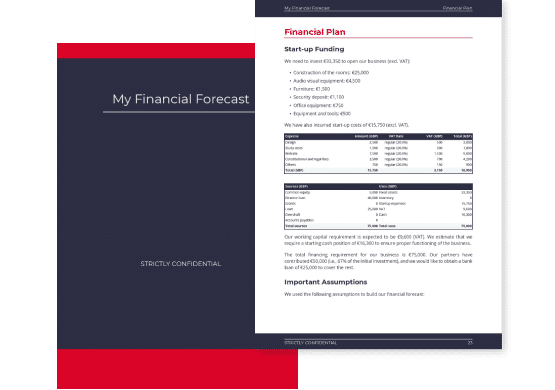
When seeking financing, your forecast will be incorporated into your business plan, which is the document you will use to present your business idea to financial partners. We'll come back to the business plan in more detail later in this guide.
Creating and updating your watch and jewellery repair shop's forecast is an ongoing process. Indeed, having up-to-date financial projections is the only way to maintain visibility over your company's future cash flow and cash position.
Forecasting is, therefore, the financial management tool that will be with you throughout the life of your company. Once you've started trading, you'll need to regularly compare the difference between your actual accounts and your forecasts, and then adjust them to maintain visibility over your future cash flows.
What does a financial projection look like?
The following financial tables will be used to present your watch and jewellery repair shop's financial forecast.
The projected P&L statement
Your watch and jewellery repair shop's forecasted P&L statement will enable you to visualise your watch and jewellery repair shop's expected growth and profitability over the next three to five years.
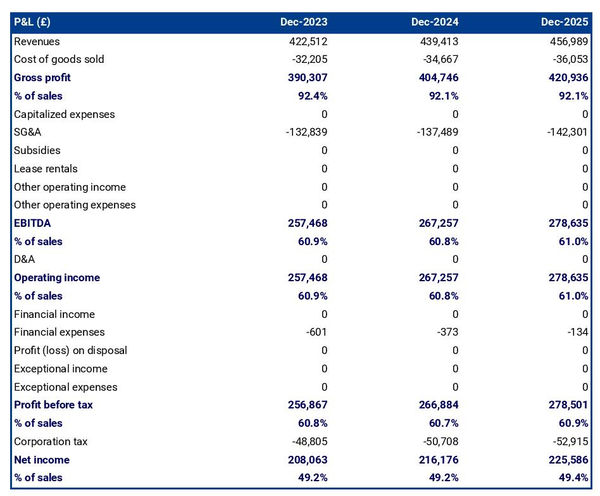
The projected balance sheet of your watch and jewellery repair shop
The projected balance sheet gives an overview of your watch and jewellery repair shop's financial structure at the end of the financial year.
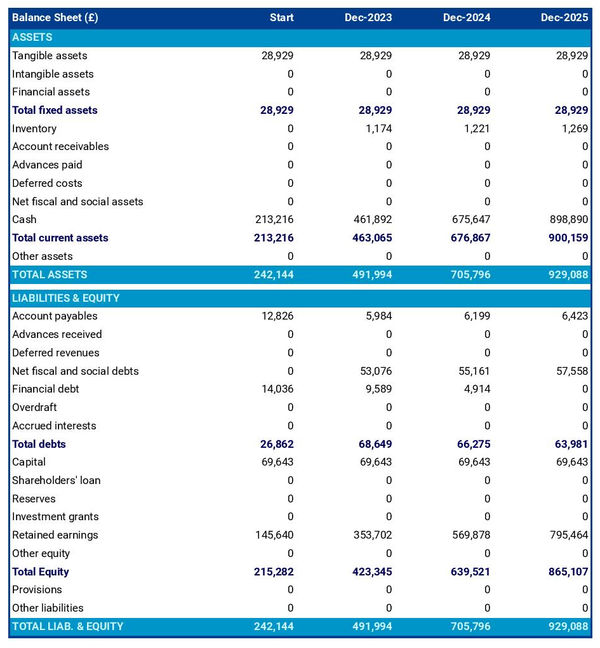
The cash flow projection
A cash flow forecast for a watch and jewellery repair shop shows the projected inflows and outflows of cash over a specific period, providing insights into liquidity and financial health.
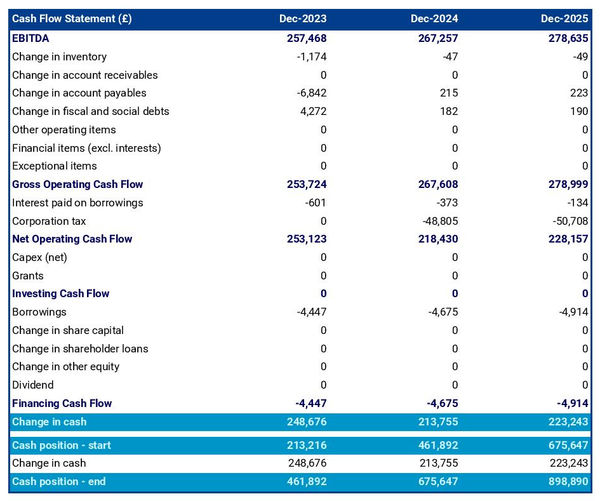
What is the best financial forecasting tool for starting your watch and jewellery repair shop?
The simplest and easiest way to create your watch and jewellery repair shop's projections is to use professional online financial forecasting software such as the one we offer at The Business Plan Shop.
There are several advantages to using specialised software:
- You can easily create your financial forecast by letting the software take care of the financial calculations for you without errors
- You have access to complete financial forecast templates
- You get a complete financial forecast ready to be sent to your bank or investors
- The software helps you identify and correct any inconsistencies in your figures
- You can create scenarios to stress-test your forecast's main assumptions to stress-test the robustness of your business model
- After you start trading, you can easily track your actual financial performance against your financial forecast, and recalibrate your forecast to maintain visibility on your future cash flows
- You have a friendly support team on standby to assist you when you are stuck
If you are interested in this type of solution, you can try our forecasting software for free by signing up here.
Choose a name and register your watch and jewellery repair shop
The next phase in launching your watch and jewellery repair shop involves selecting a name for your company.
This stage is trickier than it seems. Finding the name itself is quite fun; the difficulty lies in finding one that is available and being the first to reserve it.
You cannot take a name that is similar to a name already used by a competitor or protected by a registered trademark without inevitably risking legal action.
So you need to find a name that is available, and be able to register it before someone else can.
In addition, you will probably want to use the same name for:
- Your company’s legal name - Example LTD
- Your business trading name - Example
- The trademark - Example ®
- Your company’s domain name - Example.com
The problem is that the procedures for registering these different names are carried out in different places, each with their own deadlines:
- Registering a domain name takes only a few minutes
- Registering a new trademark takes at least 12 weeks (if your application is accepted)
- The time taken to register a new business depends on the country, but it's generally fast
You will therefore be faced with the choice of: either registering everything at once and hoping that your name will be accepted everywhere, or proceeding step by step in order to minimise costs, but taking the risk that someone else will register one of the names you wanted in the meantime.
Our advice is to discuss strategy with your legal counsel (see further down in this guide) and prioritise your domain names and registered trademarks. You'll always have the option of using a trade name that's different from your company's legal name, and that's not a big deal.
To check that the name you want is not already in use, you should consult:
- Your country's business register
- The relevant trademark registers depending on which countries you want to register your trade mark in
- A domain name reservation company such as GoDaddy
- An Internet search engine
In this area too, your legal counsel will be able to help with the research and formalities.
Need inspiration for your business plan?
Avoid writer's block and draft your own business plan in no time by drawing inspiration from dozens of business plan templates.

What corporate identity do I want for my watch and jewellery repair shop?
The following step to start a watch and jewellery repair shop is to define your company's visual identity.
Visual identity is part of the DNA of your watch and jewellery repair shop: it makes you recognizable and recognized by your customers, and helps you stand out from the competition. It also helps convey your values, notably through the choice of colors that identify the company.
Creating your business's visual identity yourself is entirely possible: there are several online tools that let you generate color palettes, choose typography and even generate logos.
However, we advise you to delegate this task to a designer or a communications agency for a professional result.
Your corporate identity will include the following elements:
- Your business logo
- Your brand guidelines
- Your business cards
- Design and theme of your website
Logo
Your watch and jewellery repair shop's logo serves as a quick identifier for your company. It will be featured on all your communication platforms (website, social networks, business cards, etc.) and official documents (invoices, contracts, etc.).
Beyond its appearance, your logo should be easy to use on any type of support and background (white, black, gray, colored, etc.). Ideally, it should be easy to use in a variety of colors.
Brand guidelines
One of the challenges when starting a watch and jewellery repair shop is to ensure a consistent brand image wherever your company is visible.
This is the role of your company's brand guidelines, which defines the typography and colors used by your brand and thus acts as the protector of your brand image.
Typography refers to the fonts used (family and size). For example, Trebuchet in size 22 for your titles and Times New Roman in size 13 for your texts.
The colors chosen to represent your brand should typically be limited to five (or fewer):
- The main colour,
- A secondary colour (the accent),
- A dark background colour (blue or black),
- A grey background colour (to vary from white),
- Possibly another secondary colour.
Business cards
Classic but a must-have, your business cards will be at your side to help you easily communicate your contact details to your founders, customers, suppliers, recruitment candidates, etc.
In essence, they should feature your logo and adhere to the brand guidelines mentioned earlier.
Website theme
Likewise, the theme of your watch and jewellery repair shop website will integrate your logo and follow the brand guidelines we talked about earlier.
This will also define the look and feel of all your site's graphic elements:
- Buttons
- Menus
- Forms
- Banners
- Etc.
What legal steps are needed to start a watch and jewellery repair shop?
The next step in opening a watch and jewellery repair shop is to look in detail at the legal and regulatory formalities.
Although it is possible to do the formalities yourself and draft some of the documents detailed here, The Business Plan Shop recommends that you seek advice on these aspects from a law firm.
Registering a trademark and protecting the intellectual property of your watch and jewellery repair shop
One of the first things you need to do here is to protect your company's current and future intellectual property.
One way of doing this is to register a trade mark, as mentioned earlier in this guide. Your lawyer will be in a position to do the formalities for you and to help you select the classes (economic activities) and jurisdictions in which you have an interest in obtaining protection.
Your law firm can also advise you on other ways of protecting your company's intellectual property.
Preparing the legal documents for your watch and jewellery repair shop
Your watch and jewellery repair shop will need a set of legal and contractual documents to operate on a daily basis.
Your exact needs in this respect will depend on the country in which you are launching your watch and jewellery repair shop and the size and legal form envisaged for the company. Once again, we highly recommend having these documents prepared by your lawyer.
As a minimum, we recommend that you have the following documents prepared:
- Employment contracts
- General terms and conditions of sale
- General terms and conditions of use for your website
- Privacy Policy for your website
- Cookie Policy for your website
- Invoices
- Etc.
Applying for licences and permits and registering for various taxes
Here too, the list of licences and business permits required for your business to operate legally will depend on the country in which you have decided to start your watch and jewellery repair shop.
Your law firm will be able to advise you on all the regulations applicable to your business.
Likewise, your accountant will be able to assist you and take care of the formalities involved in complying with the tax authorities.
Need a convincing business plan?
The Business Plan Shop makes it easy to create a financial forecast and write a business plan to help convince investors that your business idea can be profitable.

Create a business plan for your watch and jewellery repair shop
The next step to open a watch and jewellery repair shop: put together your business plan.
What is a business plan?
To keep it simple, a business plan comprises two crucial components:
- Firstly, a numerical part, the financial forecast (which we mentioned earlier), which highlights the initial financing requirements and profitability potential of the watch and jewellery repair shop,
- And a written, well-argued section that presents your project in detail, aims to convince the reader of its chances of success, and provides the context needed to assess whether the forecast is realistic or not.
The business plan will enable you to verify the coherence of your project, and ensure that the company can be profitable before incurring further costs. It will also help you convince business and financial partners.
As you can see, your business plan must be convincing and error-free.
How to write a business plan for a watch and jewellery repair shop?
Nowadays, the modern and most efficient way to write a watch and jewellery repair shop business plan is to use startup business plan software like the one we offer at The Business Plan Shop.
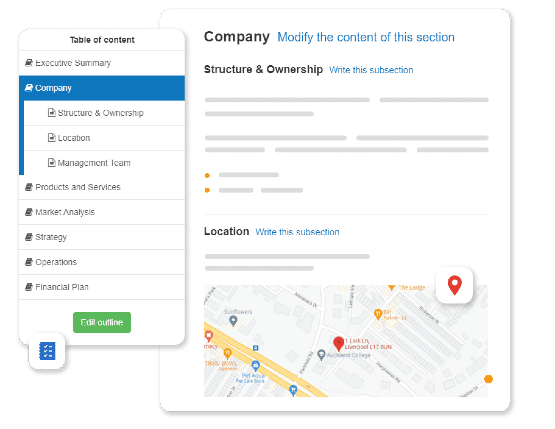
Using The Business Plan Shop to create a business plan for awatch and jewellery repair shop has several advantages :
- You can easily create your financial forecast by letting the software take care of the financial calculations for you without errors
- You are guided through the writing process by detailed instructions and examples for each part of the plan
- You can access a library of dozens of complete startup business plan samples and templates for inspiration
- You get a professional business plan, formatted and ready to be sent to your bank or investors
- You can create scenarios to stress test your forecast's main assumptions
- You can easily track your actual financial performance against your financial forecast by importing accounting data
- You can easily update your forecast as time goes by to maintain visibility on future cash flows
- You have a friendly support team on standby to assist you when you are stuck
If you're interested in using this type of solution, you can try The Business Plan Shop for free by signing up here.
Need a convincing business plan?
The Business Plan Shop makes it easy to create a financial forecast and write a business plan to help convince investors that your business idea can be profitable.

Financing the launch of your watch and jewellery repair shop
Once your business plan has been written, you’ll need to think about how you might secure the funding required to open your watch and jewellery repair shop.
The amount of initial financing required will of course depend on the size of your watch and jewellery repair shop and the country in which you wish to set up.
Financing your startup will probably require you to obtain a combination of equity and debt, which are the primary financial resources available to businesses.
Equity funding
Equity refers to the amount of money invested in your watch and jewellery repair shop by founders and investors and is key to starting a business.
Equity provides your company with stable, long-term (often permanent) capital. It also demonstrates the commitment of the company's owners to the project, since these sums can be lost in the event of bankruptcy.
Because the equity invested by the founders may be lost if the project doesn't succeed, it signals to investors and other financial institutions the founders' strong belief in the business's chances of success and might improve the likelihood of obtaining further funding as a result.
In terms of return on investment, equity investors receive dividends paid by the company (provided it is profitable) or realise capital gains by reselling their shares (provided they find a buyer interested in the company).
Equity investors are, therefore, in a very risky position. They stand to lose their initial investment in the case of bankruptcy and will only obtain a return on investment if the business manages to be profitable or sold. On the other hand, they could generate a very high return if the venture is a financial success.
Given their position, equity investors are usually looking to invest in business ventures with sufficient growth and profitability potential to offset their risk.
From the point of view of the company and its creditors, equity reduces risk, since equity providers finance the company and are only remunerated in the event of success.
From a technical standpoint, equity consists of:
- Share capital and premiums: which represent the amount invested by the shareholders. This capital is considered permanent as it is non-refundable. In return for their investment, shareholders receive shares that entitle them to information, decision-making power (voting in general assembly), and the potential to receive a portion of any dividends distributed by the company.
- Director loans: these are examples of non-permanent capital advanced to the company by the shareholders. This is a more flexible way of injecting some liquidity into your company than doing so as you can repay director loans at any time.
- Reserves: these represent the share of profits set aside to strengthen the company's equity. Allocating a percentage of your profits to the reserves can be mandatory in certain cases (legal or statutory requirement depending on the legal form of your company). Once allocated in reserves, these profits can no longer be distributed as dividends.
- Investment grants: these represent any non-refundable amounts received by the company to help it invest in long-term assets.
- Other equity: which includes the equity items which don't fit in the other categories. Mostly convertible or derivative instruments. For a small business, it is likely that you won't have any other equity items.
The main sources of equity are as follows:
- Personal contribution from the founders' savings.
- Private investors: business angels, friends and family.
- Crowdfunding campaigns to find investors or collect donations (usually in exchange for a gift).
- Government initiatives such as loans on favourable terms to help partners build up their start-up capital.
Debt funding
Another option for partially funding your watch and jewellery repair shop is to borrow.
By definition, debt works in the opposite way to equity:
- Debt needs to be repaid, whereas equity is permanent.
- Lenders get a contractually guaranteed return, whereas equity investors only generate a return if the company is a success.
When a company borrows money, it agrees to pay interest and repay the borrowed principal according to a pre-established schedule. Therefore, lenders make money regardless of whether the company is profitable and their main risk is if the company goes bankrupt.
To limit their risk, lenders are usually conservative and cautious in their approach. They only finance projects where they are confident that they will be repaid in full.
Companies borrow in two ways:
- Against their assets: this is the most common way of borrowing. The bank finances a percentage of the price of an asset (a vehicle or a building, for example) and takes the asset as collateral. If the company cannot repay, the bank seizes the asset and sells it to limit its losses.
- Against their future cash flows: the bank evaluates the company's financial forecast to estimate its borrowing capacity and assesses the conditions (amount, interest rate, term, etc.) on which it is prepared to lend, taking into account the credit risk posed by the company.
It's difficult to borrow against future cash flow when setting up a watch and jewellery repair shop, because the business doesn't yet have historical data to reassure lenders about the credibility of the forecasted cash flows.
Borrowing against assets is, therefore, often the only option available to entrepreneurs. What's more, the assets that can be financed with this option must be easy to resell, in the unfortunate event that the bank is forced to seize them, which may limit your options even further.
In terms of possible sources of borrowing, the main sources here are banks and credit institutions. Bear in mind, however, that each institution is different, both in terms of the risk it is prepared to accept and in terms of how the risk of your project will be perceived and what items it will agree to finance.
In some countries, it is also possible to borrow from private investors (directly or via crowdlending platforms) or other companies, but not everywhere.
Things to remember about financing a watch and jewellery repair shop
There are various ways you can raise the initial financing you need to open your watch and jewellery repair shop. A minimum amount of equity will be needed to give the project credibility, and bank financing can be sought to complete the package.
What to do after launching my watch and jewellery repair shop?
Launching your watch and jewellery repair shop is the beginning of an exciting entrepreneurial adventure, and the culmination of your efforts to turn your idea into a reality. But this is also when the real work begins.
As you know, nearly half of all new businesses fail, so you'll need to do everything you can to make your business sustainable right from the start.
Estimating the future financial performance of a watch and jewellery repair shop inevitably involves a degree of uncertainty. That's why we recommend simulating several scenarios: a central case with the most likely scenario, an optimistic case, and a pessimistic case designed to test the limits of your business model.
Normally, your company's actual financial performance, observed after you start trading, should fall somewhere between your pessimistic and optimistic cases.
The important thing will be to quickly measure and compare this actual performance with the figures in your forecast to see where you stand, then update the forecast to re-estimate the future cash flows and cash position of your watch and jewellery repair shop.
This forward-looking financial management exercise is the only way to know where you stand and where you're going. And, when your figures fall short of expectations, to quickly implement actions to turn things around before the company runs out of cash.
There's nothing more dangerous than waiting until you have your accounts, which takes up to nine months after the end of your financial year (if you are in the UK, abroad your mileage will vary), to then realize that you're not on the right track and that your watch and jewellery repair shop won't have enough cash to operate over the next twelve months.
This is where using a forecasting solution that integrates actuals vs. forecast tracking, like The Business Plan Shop's financial dashboards do, can simplify the financial management of your business and help reduce the risk associated with your start-up project.
Need inspiration for your business plan?
Avoid writer's block and draft your own business plan in no time by drawing inspiration from dozens of business plan templates.

Key takeaways
- This guide outlines the 15 key steps to open a watch and jewellery repair shop.
- The financial forecast is the tool that will enable you to validate the financial viability of your business idea.
- The business plan is the document that will enable you to approach your financial and commercial partners to convince them of the strengths of your project and secure the financing you need to launch your business.
- The real work begins once you've launched your business, and the only way to maintain visibility of your company's future cash flow is to keep your forecast up to date.
- Using a financial planning and analysis platform that combines forecasting, business planning and actual vs. forecast tracking and monitoring, such as The Business Plan Shop, makes the process easier and reduces the risks involved in starting a business.
We hope this guide has helped you understand how to start a watch and jewellery repair shop. Please don't hesitate to contact us if you have any questions.
Also on The Business Plan Shop
Do you know someone who wants to know how to open a watch and jewellery repair shop? Share our guide with them!



